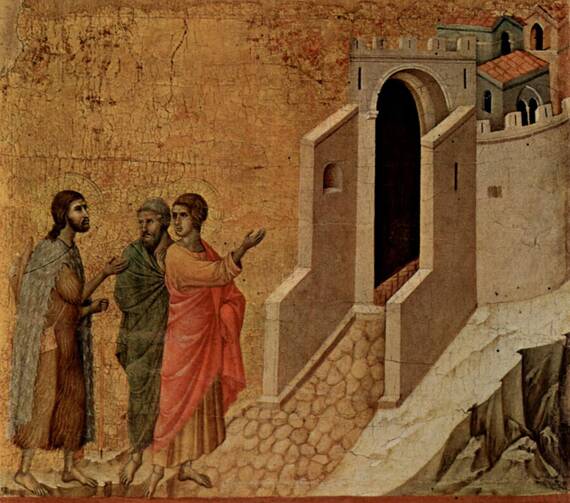One of the most fascinating aspects for me of the post-Resurrection accounts of Jesus is the theme of non-recognition. In the story of the disciples on the Road to Emmaus, Luke writes, "While [the disciples] were talking and discussing together, Jesus himself drew near and went with them. But their eyes were kept from recognizing him." In John's Gospel, as Mary Magdalene weeps at the empty tomb, John reports that "she turned round and saw Jesus standing, but she did not know that it was Jesus." In the next chapter, when Jesus greets the apostles as they fish, we read, "Jesus stood on the beach; yet the disciples did not know that it was Jesus."
The theme of spiritual vision is prominent in scripture, and many scholars have unfolded the meaning of these rich passages. In the midst of our daily routines, Jesus can be standing right in front of us, and we might not know. We can, in one sense, see everything, and yet remain badly blind.
Another important aspect of these passages, however, starts with the fact that Jesus is also the incarnation and the fullness of truth (cf. Jn 14:6). Christ is the logos (Jn 1:1), the reason and intelligibility that permeates the universe and enables us to participate fruitfully in this intelligibility.
Reviewing the passages through this lens, then, they stand not only for the failure to recognize Jesus. They also stand for the failure to recognize truth. In so doing, they continue the theme that emerges with painful poignancy during Jesus' appearance before Pilate: Truth can be right next to us, staring us in the face, and we can ignore it or defy it with apathy.
What prevents this recognition? Why can't we see what's right in front of us? In the cases of the post-Resurrection appearances, Mary and the others were thinking still as humans. Whatever Jesus might have said or hinted at during his ministry, his followers were not expecting Easter morning. It was too incredible, too . . . impossible. They hadn't fully undergone that metanoia, the complete change of mind and heart (Mk 1:15), that enabled them to read the world with a new interpretive key.
What enabled the recognition? Mary Magdalene recognizes Jesus when he calls her by name. In the next chapter, Peter recognizes Jesus after he tells the apostles to cast on the other side of the boat and they catch more fish than they can handle. And in Luke, the disciples recognize Jesus once they demonstrate their hospitality. After a long conversation about Scripture, they understand it's Jesus once they invite him to join them in the breaking of bread.
These stories speak to me not only as a believer moving toward stronger belief, but also as an educator. Education seeks to draw students to the fullness of truth. If sometimes we are unable to see Jesus, we are also, by extension, sometimes unable to see truth. The Gospels, then, offer teachers wisdom as we seek to illuminate the truth for students. Just as Jesus couldn't be recognized through a normal, pre-Easter lens, so too will truth in other forms, in all the ways that logos manifests in the arts, the sciences, mathematics, philosophy and language, require a new perspective, a shift in thinking. How does this shift come about?
I think it starts with teachers modeling Jesus and what he did to trigger recognition. We must, in our context, come to the shore and call students by name -- we must show them they are not just one among many, not just a freshman or a sophomore, not just an athlete or a SAT score: rather, they are unique, individual persons who are appreciated, cared for, and known. As in the story of Emmaus, educators must also create a hospitable environment, an experience analogous to a breaking of bread. What would it mean for the classroom to have a Eucharistic feel, an integration of fellowship and community (even food!), where conversation and accompaniment go hand in hand?








